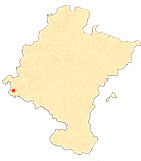Front façade of the parish church of Santa María de Viana
David, St. Johnny and Zechariah
Finishing off the doorway, above the exedra, is a straight triangular pediment with modillions on the lower part of the moldings, and two straight frames, with decoration of cut leather and flat ribbons, that frame tondos, on the pilasters that finish off the lateral streets. The first, of great simplicity, is centered by a medallion in which the bust of King David is placed, while the lateral tondos inscribe in their interior the figures of Saint John, the one on the left side, and Zechariah, the one on the right side. David is represented in bust, in a marked high relief, in mature age and bearded, with the harp alluding to his condition of musician of king Saul in his hand. St. John the Baptist figures in a desert landscape, dressed in camel skin and a tunic, with long hair and bearded, carrying with his left hand the cross and with his right hand pointing to the lamb, symbol of Christ, which is lying on the trunk of a tree and a book. While Zechariah is represented as a prophet of the Old Testament, holding a phylactery in his hands, and inscribed in a landscape similar to that of St. John.
The figure of King David is also a common image in Christian iconography, especially as an ancestor of the Virgin and Jesus, being one of the prefigurations of Christ. Likewise, the figure of St. John the Baptist must be related to that of Jesus, since he was his precursor, while Zechariah appears as a representative of the prophets of the Old Testament. All of them proclaimed and announced the coming of Christ and how through his sacrifice humanity would achieve redemption, symbolically united in these figures, which represent the Old and New Testaments.
-
ESTEBAN LORENTE, J.F., "El arco de ingreso de la colegiata de Santa María de Viana. Horóscopo de Cristo", Berceo, 130, 1996, pp. 177-178.
-
ESTEBAN LORENTE, J.F., "Los dioses paganos en las iglesias españolas del siglo XVI", bulletin del Museo e high school Camón Aznar, LXXXII, Zaragoza, high school Camón Aznar, 2000, pp. 157-190.
-
FERNÁNDEZ GRACIA, R., (coord.), ECHEVERRIA GOÑI, P.L., and GARCÍA GAINZA, M. C., El arte del Renacimiento en Navarra, Pamplona, Gobierno de Navarra, 2005, pp. 111-114.
-
GARCÍA GAINZA, M. C., HEREDIA MORENO, M. C., RIVAS CARMONA, J. and ORBE SIVATTE, M., Catalog Monumental de Navarra. V. II**. Merindad de Estella, Pamplona, 1980, pp. 559-564.
-
GONZÁLEZ DE ZÁRATE, J. M., "Aproximaciones a la lectura iconográfica del programa mitológico en la portada de Santa María de Viana", Primer congress General de Historia de Navarra, anejo 11, Pamplona, Príncipe de Viana, 1988, pp. 179-196.
-
LABEAGA MENDIOLA, J.C., Viana monumental y artística, Pamplona, Príncipe de Viana, 1984, pp. 229-236.












